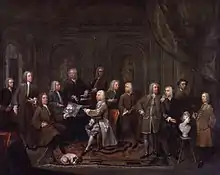Rose and Crown Club
The Rose and Crown Club was a club for artists, collectors and connoisseurs of art in early 18th-century London, England.

History
The Rose and Crown Club "for Eminent Artificers of this Nation"[1][2] was formed by 1704, when the engraver George Vertue was admitted;[3] while it lasted, the club was among the more important of clubs for artists and connoisseurs.[4] According to John Smibert's biographer Richard Saunders, the club was initially "a bawdy assembly of younger artists and cognoscenti, which met weekly"[5]: 869 and apparently held its meetings at the Rose and Crown public house.[6] in addition to Vertue, members included Bernard Lens III,[7] Christian Friedrich Zincke, William Hogarth, Peter Tillemans,[8] Marcellus Laroon the Younger and Michael Dahl.
The members of the club were known as the 'Rosacoronians'. An unfinished Hogarthian conversation piece[9] painting in the Ashmolean Museum attributed to the Scottish painter Gawen Hamilton (another member), An Assembly of Virtuosi, shows a group of fifteen men, including eight who are identified in an etching of the painting by R. Cooper, published by W. B. Tiffin (1829),[10] and it has been suggested that this is a group portrait of the Rosacoronians. The group includes Hamilton himself, Michael Dahl, John Vanderbank, the architect William Kent, and John Michael Rysbrack the sculptor.[11] Vertue listed the painter and engraver Gerhard Bockman as a member in 1724.[12]
The club was well connected with the older-established Virtuosi of St Luke (c. 1689–1743), with which it is sometimes confused, although it was less prestigious.[2]
The Rose and Crown Club remained in existence until 1745 and held its last meeting at the Half-Moon Tavern.[13] Bignamini notes that
The meetings and annual feasts of the Virtuosi of St Luke and of the Rose and Crown Club had come to a definitive end in 1745.[14][15]
References
- Appleby 1996, pp. 7–8.
- Bignamini, Ilaria (1996). "London, §III, 4: Art life and organization, 1660–1768". In Turner, Jane (ed.). The Dictionary of Art. Vol. 19. New York: Grove's Dictionaries. pp. 583–586. ISBN 1-884446-00-0. OCLC 1033643331.
- Whitley, William T.. Artists and Their Friends in England, 1700-1799, (The Medici Society, 1928) vol. I p 7.
- Saunders 1995, p. 43.
- Saunders, Richard H. (1996). "Smibert, John". In Turner, Jane (ed.). The Dictionary of Art. Vol. 28. New York: Grove's Dictionaries. pp. 869–871. ISBN 1-884446-00-0. OCLC 1033666104 – via the Internet Archive.
- Finberg 1918, p. 57.
- Coombs, Katherine (2004). "Lens [Laus] family". In Matthew, H. C. G. & Harrison, Brian (eds.). Oxford Dictionary of National Biography. Vol. 33. Oxford, New York: Oxford University Press. pp. 380–382. ISBN 0-19-861383-0. OCLC 1035759110 – via the Internet Archive. Also available via Oxford DNB Online (subscription or UK public library membership required).
{{cite encyclopedia}}: External link in|postscript= - Bottoms, Edward (2004). "Tillemans, Peter". In Matthew, H. C. G. & Harrison, Brian (eds.). Oxford Dictionary of National Biography. Vol. 54. Oxford, New York: Oxford University Press. pp. 778–779. ISBN 0-19-861404-7. OCLC 1035758398 – via the Internet Archive. Also available via Oxford DNB Online (subscription or UK public library membership required).
{{cite encyclopedia}}: External link in|postscript= - Long attributed to Hogarth, on the basis of an attached note said to be by Alderman John Boydell, to whom it once belonged, and whose note called it an "early painting by Hogarth" (Whitley 1928: I, p. 70f)
- Whitley 1928 I, pp 70f, which notes that, in the description of the painting published in the Literary Gazette (1827), the tablet in the room is said to bear names "of whom we can make out the following:— Hamilton, Dahl, Laroon, Gibbon or Gibson, Rysbrach, Vanderbank, Bridgman and Kent." The celebrated carver Grinling Gibbons died in 1721.
- Harrison, Colin, et al., Ashmolean Museum: Complete Illustrated Catalogue of Paintings (Ashmolean Museum, 2004, ISBN 1-85444-188-4), p. 97; Gawen Hamilton also painted a Club of Artists that gathered at the King's Arms in New Bond Street and included some of the same men: Hamilton, Vertue, Dahl, Rysbrack and Kent among the others. (Whitley p. 68)
- Grindle, Nicholas (2004). "Bockman, Gerhard". In Matthew, H. C. G. & Harrison, Brian (eds.). Oxford Dictionary of National Biography. Vol. 6. Oxford, New York: Oxford University Press. pp. 390–391. ISBN 0-19-861356-3. OCLC 1035755389 – via the Internet Archive. Also available via Oxford DNB Online (subscription or UK public library membership required).
{{cite encyclopedia}}: External link in|postscript= - Whitley 1928, vol. 1, p. 70.
- Hargraves, Matthew (2006). Candidates for Fame. New Haven, London: Yale University Press. p. 193, footnote 57. OCLC 1027489018.
- Bignamini 1988, p. 106.
Further reading
- Appleby, John H. (1996). "A new perspective on John Rowley, Virtuoso Master of mechanics and hydraulic engineer". Annals of Science. 53 (1): 1–27. doi:10.1080/00033799600200101.
- Bignamini, Ilaria (1988). "George Vertue, Art Historian and Art Institutions in London, 1689–1768: A Study of Clubs and Academies". The Walpole Society. 54: 1–148. JSTOR 41829562.
- Finberg, Hilda F. (1918). "Gawen Hamilton: An Unknown Scottish Portrait Painter". The Walpole Society. 6: 51–58. JSTOR 41830003.
- Saunders, Richard H. (1995). John Smibert: Colonial America's First Portrait Painter. New Haven, London: Yale University Press. ISBN 0-300-04258-2.
- Vertue, George (1934). "The Note-Books of George Vertue Relating to Artists and Collections in England (III)". The Walpole Society. 22. whole issue. JSTOR i40086509.